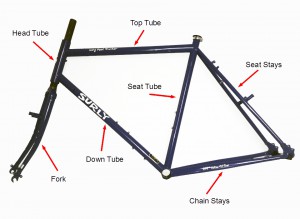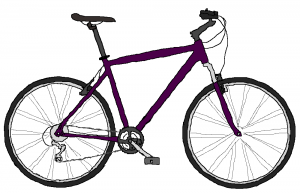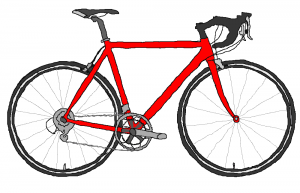There are so many different types of frame on today’s market that it initially makes your decision quite difficult. I hope this section will help you to choose the type frame that is right for you and your tour.
When you are shopping for a frame, it’s handy to know the the names of the different frame parts:
Touring Frames – purpose built for the job at hand. This type of frame is the logical choice for long journeys or journeys over rough terrain. Generally made from steel, they are tough and easy to repair with the right welding equipment. Touring frames tend to have a longer wheel-base which provides greater stability when loaded. They also have all the fittings installed for things like extra water bottles, pannier racks and mudguards etc. Your choices are quite limited, however, as many well known cycling brands are consolidating and dropping them from their product lines.
Mountain Bike Frames – usually built to withstand the bumps and shocks associated with off-road riding. They are made from a variety of materials: steel, carbon fibre, aluminium etc. Mountain bike frames are designed to accommodate shock absorbers (rear and/or front shocks). Shock absorbers make your ride smoother, but also bleed momentum and power from every pedal stroke. Some front shock absorbing forks are capable of being “locked-off” so that they work as a solid stem. For shorter tours or tours in areas with good bike shops and mechanics this type of fork could be an asset on rough terrain. I wouldn’t recommend them for trips outside of these constraints unless you are prepared to maintain/repair them yourself.
Sports/Lifestyle Frames – light weight frames that are designed for commuting and weekend riding. As with other frame types they are also built from a variety of materials. While resembling a touring bike, these frames tend to have a shorter wheelbase, and are therefore provide marginally less stability than a touring-specific frame. Some of these frames are designed to work with a front fork that includes shock absorbers, see the discussion on mountain bike frames for more information.
Road Frames – are lightweight and built for speed. They are constructed out of various materials, usually aluminium alloys and carbon fibre. The standard wheel size for a road frame is 700c – see discussion on wheels following. This sort of frame would be suited to a supported tour, where your luggage is carried in a support vehicle, on roads that are smooth and consistent.
A Note on Frame Materials
As discussed above, frames are constructed from various combinations of materials. It is important to be aware of the requirements for fixing these different types of materials should they break – either through the stresses associated with wear and tear or a catastrophic failure associated with a collision:
- Steel – can be repaired using conventional welding equipment, like the kind found in a steel workshop anywhere in the world.
- Aluminium and Titanium – both require specialised welding equipment, particularly titanium.
- Carbon Fibre – difficult (sometimes impossible) to repair, requires specialist equipment and expertise.
Compatibility
Don’t panic if you don’t understand all these terms, they are discussed in detail in the following pages.
- Wheels – frames are made for different wheel geometry, usually a choice between 700c (eg. road bike wheels) or 26″ (eg. mountain bike wheels).
- Brakes – the attachment points (technical term is brazons) and the spacing of the rear stays may limit your choice of braking systems.
- Seat post – the diameter of the seat tube on the frame must match the diameter of any seat post you install.
- Headset – the diameter of the head tube of the frame dictates the size and type of headset you can install.
- Bottom Bracket – the dimensions of the housing for the bottom bracket in the frame will dictate the size of the bottom bracket to install.
- Tyre clearance – the frame will have a set tyre clearance which will dictate the size of the tires you can use, this will also impact the fitting of fenders/mudguards.




